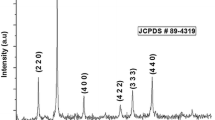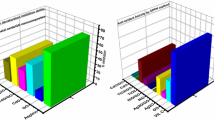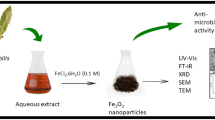Abstract
Graphenic nanomaterials like fullerenes, carbon nanotubes (CNT), and carbon black (CB) are known to scavenge free radicals. This antioxidant activity makes these materials promising in all applications where radical reactions need to be controlled. Therefore, CNT and fullerenes has been proposed as stabilising additives for composites and in medicine to prevent free-radicals-mediated diseases. CB has been used for more than a century as a stabilising filler in rubbers. The mechanisms responsible of the scavenging activity and the role of the nanoparticles structure in the antioxidant potency are still poorly known. In the present study, two samples of very pure soot having different structure were prepared as model of graphenic nanoparticles and tested for their capability to scavenge hydroxyl radicals by means of electron paramagnetic resonance (EPR)/spin trapping technique. The mechanism of the reactions occurring between the soot samples and the free radicals was evaluated by EPR spectroscopy of the dry powder while the possible introduction of oxygenated acidic functionalities during the reaction was evaluated by titration and confirmed by measuring the variation in ζ-potential of particles. The results indicate that soot persistently scavenge hydroxyl radicals through a reaction leading to the introduction of acidic functionalities at the surface. The scavenging activity was found to depend upon the bulk/surface structure of soot. When tested on alveolar macrophages MH-S cells, both samples did not induce cell damage (lactate dehydrogenase leakage) and oxidative stress (intracellular GSH depletion), suggesting a possible safe use of graphenic nanoparticles.






Similar content being viewed by others
References
Foucaud, L., Wilson, M. R., Brown, D. M., Stone, V. (2007). Measurement of reactive species production by nanoparticles prepared in biologically relevant media. Toxicology Letters, 174, 1–9.
Oberdoster, G. (2001). Pulmonary effect of inhaled ultra fine particle. International Archives of Occupational and Environmental Health, 74, 1–8.
Panessa-Warren, B. J., Warren, J. B., Wong, S. S., Misewich, J. A. (2006). Biological cellular response to carbon nanoparticle toxicity. Journal of Physics: Condensed Matter, 18, 2185–2201.
Hayes, B. S. (1991). Soot and hydrocarbons in combustion. In W. Bartok A. F. Sarofim (Eds.), Fossil fuel combustion (pp. 261–327). New York: Wiley.
Watson, A. J., & Valberg, P. A. (2001). Carbon black and Soot: two different substances. AIHAJ American Industrial Hygiene., 62, 218–228.
Mills, N. L., Donaldson, K., Hadoke, P. W., Boon, N. A., MacNee, W., Cassee, F. R., et al. (2009). Adverse cardiovascular effects of air pollution. Nature Clinical Practice. Cardiovascular Medicine, 6, 36–44.
Moller, W., Felten, K., Sommerer, K., Scheuch, G., Meyer, G., Meyer, P., et al. (2008). Deposition, retention, and translocation of ultrafine particles from the central airways and lung periphery. American Journal of Respiratory and Critical Care Medicine, 177, 426–432.
Donaldson, K., Stone, V., Borm, P. J., Jimenez, L. A., Gilmour, P. S., Schins, R. P., et al. (2003). Oxidative stress and calcium signaling in the adverse effects of environmental particles (PM10) Free Rad. Biologie Médicale, 34, 1369–1382.
Choi, H. S., Aschitate, Y., Lee, J. H., Kim, S. H., Matsui, A., Insin, N., et al. (2010). Rapid translocation of nanoparticles from the lung airspaces to the body. Nature Biotechnology, 28, 1300–1303.
Oberdörster, G., Sharp, Z., Atudorei, V., Elder, A., Gelein, R., Kreyling, W. (2004). Translocation of inhaled ultrafine particles to the brain. Inhalation Toxicology, 16, 437–445.
Ayres, J. G., Borm, P., Cassee, F. R., Castranova, V., Donaldson, K., Ghio, A., et al. (2008). Evaluating the toxicity of airborne particulate matter and nanoparticles by measuring oxidative stress potential: a workshop report and consensus statement. Inhalation Toxicology, 20, 75–99.
Mudway, I. S., Stenfors, N., Duggan, S. T., Roxborough, H., Zielinski, H., Marklund, S. L., et al. (2004). An in vitro and in vivo investigation of the effects of diesel exhaust on human airway lining fluid antioxidants. Archives of Biochemistry and Biophysics, 423, 200–212.
Squadrito, G. L., Cueto, R., Dellinger, B., Pryor, W. A. (2001). Quinoid redox cycling as a mechanism for sustained free radical. Free Radical Biology and Medicine, 31, 1132–1138.
Xia, T., Kovochich, M., Nel, A. (2006). The role of reactive oxygen species and oxidative stress in mediating particulate matter injury. Clinics in Occupational and Environmental Medicine, 5, 817–836.
Zhong, Y., Carmella, S. G., Upadhyaya, P., Hochalter, J. B., Rauch, D., Oliver, A., et al. (2011). Immediate consequences of cigarette smoking: rapid formation of polycyclic aromatic hydrocarbon diol epoxides. Chemical Research in Toxicology, 24, 246–252.
Li, N., Sioutas, C., Cho, A., Schmitz, D., Misra, C., Sempf, J., et al. (2003). Ultrafine particulate pollutants induce oxidative stress and mitochondrial damage. Environmental Health Perspectives, 111, 455–460.
Bonvallot, V., Baeza-Squiban, A., Baulig, A., Brulant, S., Boland, S., Muzeau, F., et al. (2001). Organic compounds from diesel exhaust particles elicit a proinflammatory response in human airway epithelial cells and induce cytochrome p450 1A1 expression. American Journal of Respiratory Cell and Molecular Biology, 25, 515–521.
Porter, D. W., Leonard, S., Castranova, V. (2007). Particle and cellular oxidative and nitrosative stress. In K. Donaldson & P. Borm (Eds.), Particle toxicology (pp. 119–138). New York: Taylor & Francis Group.
Wilson, M. R., Lightbody, J. H., Donaldson, K., Sales, J., Stone, V. (2002). Interactions between ultrafine particles and transition metals in vivo and in vitro. Toxicology and Applied Pharmacology, 184, 172–179.
Dick, C. A., Brown, D. M., Donaldson, K., Stone, V. (2003). The role of free radicals in the toxic and inflammatory effects of four different ultrafine particle types. Inhalation Toxicology, 15, 39–52.
Schins, R. P., Lightbody, J. H., Borm, P. J., Shi, T., Donaldson, K., Stone, V. (2004). Inflammatory effects of coarse and fine particulate matter in relation to chemical and biological constituents. Toxicology and Applied Pharmacology, 195, 1–11.
Garza, K. M., Soto, K. F., Murr, L. E. (2008). Cytotoxicity and reactive oxygen species generation from aggregated carbon and carbonaceous nanoparticulate materials. International Journal of Nanomedicine, 3, 83–94.
Chuang, H. C., Jones, T. P., Lung, S. C., BéruBé, K. A. (2011). Soot-driven reactive oxygen species formation from incense burning. Science of the Total Environment, 409, 4781–4787.
Jung, H., Guoa, B., Anastasio, C., Kennedy, I. M. (2006). Quantitative measurements of the generation of hydroxyl radicals by soot particles. Atmospheric Environment, 40, 1043–1052.
Shvedova, A. A., Kisin, E. R., Porter, D., Schulte, P., Kagan, V. E., Fadeel, B., et al. (2009). Mechanisms of pulmonary toxicity and medical applications of carbon nanotubes: two faces of Janus? Pharmacology and Therapeutics, 121, 192–204.
Sanchez, V. C., Jachak, A., Hurt, R. H., Kane, A. B. (2012). Biological interactions of graphene-family nanomaterials: an interdisciplinary review. Chemical Research in Toxicology, 25, 15–34.
Dugan, L. L., Turetsky, D. M., Du, C., Lobner, D., Wheeler, M., Almili, C. R., et al. (1997). Carboxy fullerenes as neuroprotective agents. Proceedings of the National Academy of Sciences, 94, 9434–9439.
Lin, A. M. Y., Chyi, B. Y., Wang, S. D., Yu, H. H., Kanakamma, P. P., Luh, T. Y., et al. (1999). Carboxyfullerene prevents iron-induced oxidative stress in rat brain. Journal of Neurochemistry, 72, 1634–1640.
Karakoti, A., Singh, S., Dowding, J. M., Seal, S., Self, W. T. (2010). Redox-active radical scavenging nanomaterials. Chemical Society Reviews, 39, 4422–4432.
Medalia, A. I., Rivin, D., Sanders, D. R. (1983). A comparison of carbon black with soot. Science of the Total Environment, 31, 1–22.
Mwila, J., Miraftab, M., Horrocks, A. R. (1994). Effect of carbon black on the oxidation of polyolefins—an overview. Polymer Degradation and Stability, 44, 351–356.
Watts, P. C. P., Fearon, P. K., Hsu, W. K., Billingham, N. C., Kroto, H. W., Walton, D. R. M. (2003). Carbon nanotubes as polymer antioxidants. Journal of Materials Chemistry, 13, 491–495.
Krusic, P. J., Wasserman, E., Keizer, P. N., Morton, J. R., Preston, K. F. (1991). Radical reaction of C60. Science, 254, 1183–1185.
Ying, Y., Saini, R. K., Liang, F., Sadana, A. K., Billups, W. E. (2003). Functionalization of carbon nanotubes by free radicals. Organic Letters, 5, 1471–1473.
Zeilanov, E. B., & Koûmehl, G. (2001). Fullerene C60 as an antioxidant for polymers. Polymer Degradation and Stability, 71, 197–202.
Fenoglio, I., Tomatis, M., Lison, D., Muller, J., Fonseca, A., Nagy, J. B., et al. (2006). Reactivity of carbon nanotubes: free radicals generation or scavenging activity? free radic. Free Radical Biology & Medicine, 40, 1227–1233.
Crouzier, D., Follot, S., Gentilhomme, E., Flahaut, E., Arnaud, R., Dabouis, V., et al. (2010). Carbon nanotubes induce inflammation but decrease the production of reactive oxygen species in lung. Toxicology, 272, 39–45.
Galano, A., Francisco-Marquez, M., Martinez, A. (2010). Influence of point defects on the free-radical scavenging capability of single-walled carbon nanotubes. Journal of Physical Chemistry C, 114, 8302–8308.
Tasis, D., Tagmatarchis, N., Bianco, A., Prato, M. (2006). Chemistry of carbon nanotubes. Chemistry Review, 106, 1105–1136.
Fenoglio, I., Greco, G., Tomatis, M., Muller, J., Raymundo-Pinero, E., Beguin, F., et al. (2008). Structural defects play a major role in the acute lung toxicity of multi-wall carbon nanotubes: physico-chemical aspects. Chemical Research in Toxicology, 21, 1690–1697.
Shukla, P. K., & Mishra, P. C. (2010). Effects of diameter, length, chirality and defects on the scavenging action of single-walled carbon nanotubes for OH radicals: a quantum computational study. Chemical Physics, 369, 101–107.
Zeylanov, E. B., Allen, N. S., Salmanova, N. I. (2009). Radical scavenging efficiency of different fullerenes C60–C70 and fullerene soot. Polymer Degradation and Stability, 94, 1183–1189.
Alfè, M., Apicella, B., Barbella, R., Rouzaud, J. N., Tregrossi, A., Ciajolo, A. (2009). Structure–property relationship in nanostructures of young and mature soot in premixed flames. Proceedings of the Combustion Institute, 32, 697–704.
Ciajolo, A., D’Anna, A., Barbella, R. (1994). PAH and high molecular weight species formed in a premixed methane flame. Combustion Science and Technology, 100, 1–6.
Alfè, M., Apicella, B., Tregrossi, A., Ciajolo, A. (2008). Identification of large plyciclic aromatic hydrocarbons in carbon particulates formed in a fuel-rich premixed ethylene flame. Carbon, 46, 2059–2066.
D’Anna, A., Ciajolo, A., Alfè, M., Apicella, B., Tregrossi, A. (2009). Effect of fuel/air ratio and aromaticity on the molecular weight distribution of soot in premixed n-heptane flames. Proceedings of the Combustion Institute, 32, 803–810.
Alfè, M., Apicella, B., Barbella, R., Tregrossi, A. (2007). Distribution of soot molecular weight/size along premixed flames as inferred by size exclusion chromatography. Energy & Fuels, 21, 136–140.
Visentin, S., Barbero, N., Musso, S., Mussi, V., Biale, C., Ploeger, R., et al. (2010). A sensitive and practical fluorimetric test for CNT acidic site determination. Chemical Communications, 46, 1443–1445.
Pietroiusti, A., Massimiani, M., Fenoglio, I., Colonna, M., Valentini, F., Palleschi, G., et al. (2011). Low doses of pristine and oxidized single wall carbon nanotubes affect mammalian embryonic development. ACS Nano, 5, 4624–4633.
Polimeni, M., Gazzano, E., Ghiazza, M., Fenoglio, I., Bosia, A., Fubini, B., et al. (2008). Quartz inhibits glucose 6-phosphate dehydrogenase in murine alveolar macrophages. Chemical Research in Toxicology, 21, 888–894.
Kroll, A., Pillukat, M. H., Hahn, D., Schnekenburger, J. (2012). Interference of engineered nanoparticles with in vitro toxicity assays. Archives of Toxicology, 86, 1123–1136.
Alfè, M., Apicella, B., Rouzaud, J. N., Tregrossi, A., Ciajolo, A. (2010). The effect of temperature on soot properties in premixed methane flames. Combustion and Flame, 157, 1959–1965.
Vander Wal, R. L., & Tomasek, A. J. (2003). Soot oxidation: dependence upon initial nanostructure. Combustion and Flame, 134, 1–9.
Russo, C., Stanzione, F., Tregrossi, A., Alfè, M., Ciajolo, A. (2012). The effect of temperature on the condensed phases formed in fuel-rich premixed benzene flames. Combustion and Flame, 159, 2233–2242.
Tuinstra, F., & Koenig, J. L. (1970). Raman spectrum of graphite. The Journal of Chemical Physics, 53, 1126–1130.
Ferrari, A. C., & Robertson, J. (2000). Interpretation of Raman spectra of disordered and amorphous carbon. Physical Review B, 61, 96–107.
Chhowalla, M., Ferrari, A. C., Robertson, J., Amaratunga, G. A. J. (2000). Evolution of sp(2) bonding with deposition temperature in tetrahedral amorphous carbon studied by Raman spectroscopy. Applied Physics Letters, 76, 1419–1421.
Alfè, M., Gargiulo, V., Ghiazza, M., Carella, E., Fenoglio, I., Ciajolo, A. (2012). The effect of nanostructure and adsorbed organic species on the radical activity of combustion-derived. In P. Manosh (Ed.), Soot: sources, formation and health effects (pp. 151–163). New York: Nova Science Publishers.
Hirsch, A. (2002). Functionalization of single-walled carbon nanotubes. Angewandte Chemie International Edition, 41(11), 1853–1859.
Li, W., Bai, Y., Zhang, Y. K., Sun, M. L., Cheng, R. M., Xu, X. C., et al. (2005). Effect of hydroxyl radical on the structure of multi-walled carbon nanotubes. Synthetic Metals, 155, 509–515.
Shi, X., Jiang, B., Wang, J., Yang, Y. (2012). Influence of wall number and surface functionalization of carbon nanotubes on their antioxidant behavior in high density polyethylene. Carbon, 50, 1005–1013.
Francisco-Marquez, M., Galano, A., Martinez, A. (2010). On the free radical scavenging capability of carboxylated single-walled carbon nanotubes" J. Physics and Chemistry C, 114, 6363–6370.
Martínez, A., Francisco-Marquez, M., Galano, A. (2010). Effect of different functional groups on the free radical scavenging capability of single-walled carbon nanotubes. The Journal of Physical Chemistry C, 114, 14734–14739.
Gazzano, E., Ghiazza, M., Polimeni, M., Bolis, V., Fenoglio, I., Attanasio, A., et al. (2012). Physicochemical determinants in the cellular responses to nanostructured amorphous silicas. Toxicological Sciences, 128, 158–170.
Liu, X., Sen, S., Liu, J., Kulaots, I., Geohegan, D., Kane, A., et al. (2011). Antioxidant deactivation on graphenic nanocarbon surfaces. Small, 19, 2775–2785.
Foucaud, L., Goulaouic, S., Bennasroune, A., Laval-Gilly, P., Brown, D., Stone, V., et al. (2010). Oxidative stress induction by nanoparticles in THP-1 cells with 4-HNE production: stress biomarker or oxidative stress signalling molecule? Toxicology In Vitro, 24, 1512–1520.
Kim, T. W., Chung, P. W., Slowing, I. I., Tsunoda, M., Yeung, E. S., Lin, V. S. J. (2008). Structurally ordered mesoporous carbon nanoparticles as transmembrane delivery vehicle in human cancer cells. Nano Letters, 8, 3724–3727.
Chandra, S., Das, P., Bag, S., Laha, D., Pramanik, P. (2011). Synthesis, functionalization and bioimaging applications of highly fluorescent carbon nanoparticles. Nanoscale, 3, 1533–1540.
Boncel, S., Artur, P., Herman, A. P., Walczak, K. Z. (2012). Magnetic carbon nanostructures in medicine. Journal of Materials Chemistry, 22, 31–37.
Aillon, K. L., Xie, Y., El-Gendy, N., Berkland, C. J., Forrest, M. L. (2009). Effects of nanomaterial physicochemical properties on in vivo toxicity. Advanced Drug Delivery Reviews, 61, 457–466.
Acknowledgements
The research leading to these results has received funding from the Accordo CNR-MSE “Carbone Pulito-CO2 capture” and Nanoparticle Impact on Pulmonary Surfactant Interfacial Properties (NIPS)—Seed Project 2009-IIT. One of the authors (EC) was a recipient of a doctoral fellowship from the Istituto Nazionale per l′Assicurazione contro gli infortuni sul lavoro (INAIL) Piemonte, Italia. The authors gratefully acknowledge Luciana Lisi from IRC-CNR for BET analyses. The micro-Raman and DLS equipment and the microplate reader were acquired by the Interdepartmental Center “G. Scansetti” for Studies on Asbestos and Other Toxic Particulates with a grant from Compagnia di San Paolo, Torino, Italy.
Author information
Authors and Affiliations
Corresponding author
Rights and permissions
About this article
Cite this article
Carella, E., Ghiazza, M., Alfè, M. et al. Graphenic Nanoparticles from Combustion Sources Scavenge Hydroxyl Radicals Depending Upon Their Structure. BioNanoSci. 3, 112–122 (2013). https://doi.org/10.1007/s12668-013-0077-6
Published:
Issue Date:
DOI: https://doi.org/10.1007/s12668-013-0077-6




